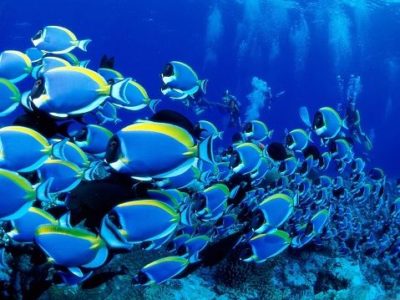Aquarium and tropical fish reproduction
Fish farming may become a business, which could provide you with a sustainable income. However, you need to have the basic knowledge about fish reproduction and concrete conditions to protect the new fishes from diseases and temperature collapses. Firstly, we’ll tell you about natural
Fish reproduction process
Most species of fishes divide into two reproduction classes – the spawners and live-bearing. The first group throws thousands of small eggs into water or pool’s bottom for external fertilization. We call them spawners because this process is called spawning. This method has a lot of varieties used by different species.
A wide number of marine inhabitants scatter their eggs. After they fall, the male representative fertilizes them with its sperm. Others release them on a flat surface. The third group builds a nest from bubbles. And some fishes carry their children inside their own mouths.
The process of live-bearing reproduction is similar to mammals or humans. The male fish fertilizes the eggs inside its female friend. After certain period ends, it bears a new member of a society. The best examples of such process are dolphins and whales.
The fish reproduction functions are open at different ages and seasons. Its longevity depends on multiple factors. The most important of which are safety, environment temperature and molecular structure. The fish vital cycle and its attractiveness for hunters depends on date of first sexual mature. For most bony fishes it hesitates between one and five years. Another species do not mature until 15 years of age.
Reproduction in captivity
If you want to earn money by breeding aquarium or pool fishes, you need to remember the following things:
- The food chain in fish world: don’t settle the species who eat each other together;
- The temperature – in some cases you need to buy special equipment to keep a constant temperature to allow your wards to mature. However, remember about necessity for them to rest and sleep during winter months;
- The presence of predators is dangerous, especially if you reproduce fish close to natural conditions.
The reproduction in captivity divides into two types. The first is sexual. It supposes the interaction of female’s oocytes with male’s sperm. It is in common with most species of marine inhabitants. The result may be bisexual when male and female individuals grow in different eggs or hermaphrodite with both genders together. However, the self- fertilization is a rare event among fishes.
Another way of reproduction is asexual. The primary example of such approach is a starfish. This aquatic inhabitant can restore its full size from the smallest part of a body.
Aquarium fish reproduction

Raising fishes in aquariums is both exciting and profitable. One of the favorite fishes with fish breeders is a clownfish. Yeah, it’s that clownfish you could see in Disney Pixar’s “Finding Nemo” animation movie. It will be our example.
The best neighbour for him is sea anemone. After you settle both to the tank, you need to wait some days for clownfish to start to spawn. While you are waiting, feed it with live or frozen artemia, dry pellets, shrimps and frozen spinach. Such diet guarantees the competitive quality of eggs and future whitebaits.
The reproduction process starts with male’s dance up and down around the female fish. After that, he cleans the rocks close to the sea anemone. When the female layered eggs, male fertilizes it. The whitebaits appear in some days. This term depends on the temperature and other factors.
These stadiums vary relating to different species. However, it’s better to remove the eggs to separate rearing tank, especially when you have several colonies with males who compete for opposite gender. They can kill the younger kids. By the way, read an article about farming trouts.
Tropical fish reproduction
This hobby requires special knowledge. You must make sure that you can create the conditions which are natural for spawning. So you need to move through these stages:
- Determine the sex of the fish. It’s easy if you deal with dimorphic species, e.g. Malawi cichlids. Males are bigger and have noticeable sex organs. The sexual isomorphic fishes are harder to identify. The male’s genital papilla becomes visible only during spawning procedure.
- Select parenting fish. Do this task carefully if you want to earn money on this. The splendid specimen guarantee good results
- The primary task is to create the sufficient conditions for future parents. It may be expensive and hard if you don’t live in tropic countries and need a specialized heating equipment.
- The spawning tank. It is important for egg scatters as they often eat their unborn kids. The quick reaction can save the eggs from hungry parents. If you don’t have it, don’t forget to feed them. If you deal with nest-builders, study which material they use and furnish your tank with it. The livebearer mothers should be fed immediately after releasing the young. After the process is finished, remove the mother from the reservoir.
Our last advice is to keep a diary and note all the wins and losses till you become a specialist in fish breeding. It will be especially helpful if you transform your hobby into a business (e.g. YouTube Channel, Website or even a real fish farm).
